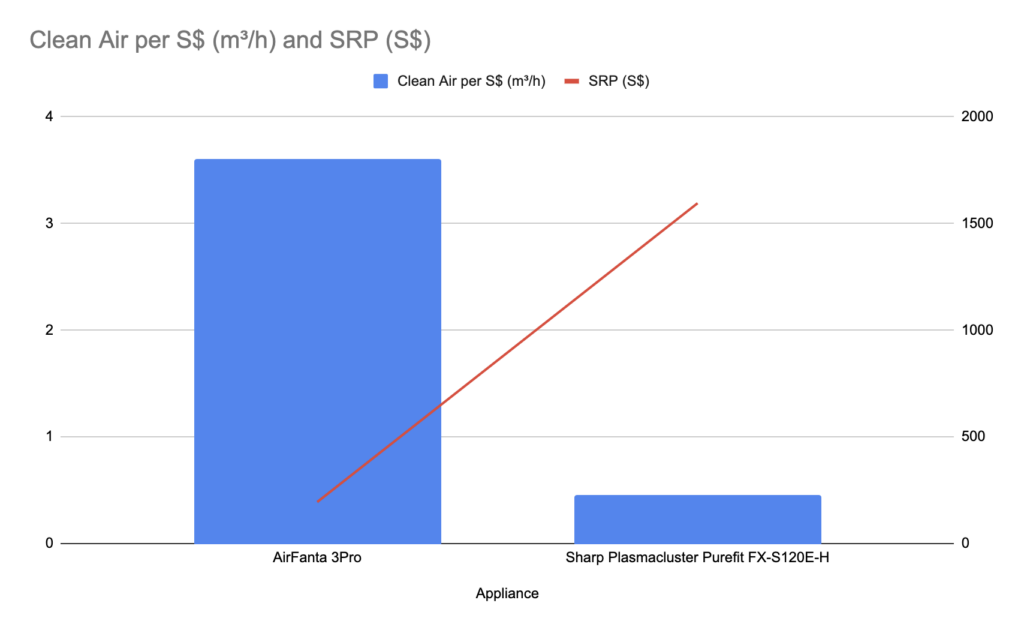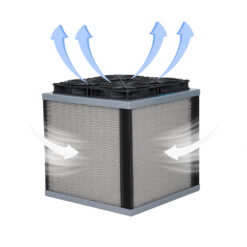There are many types of room air purifiers available in the market in Singapore, but do you know how to choose the right one for your home? In this article, we will introduce to you three simple ways to determine the best room air purifier for your home, office, and other types of commercial establishments.
What is a room air purifier?
A room air purifier, also commonly known as an air purifier, is an electrical appliance that cleans the air in an entire room. The room air purifier pulls in air through a filter to remove harmful contaminants such as virus, bacteria, dust, allergens, haze, pollen, mold, pet dander, and dust mites. If you add an activated carbon filter, it can remove chemical and gaseous contaminants such as formaldehyde, VOCs, cigarette smoke, and odors.
Although room air purifiers come in all shapes and sizes, they primarily consist of two important components – a fan and a filter.
Some air purifiers claim to have ionizers or UV that help to increase the performance of the product. However, the bulk of the air cleaning is performed by the fan and the filter.
Five things you need to look out for when choosing an air purifier
1. Clean Air Delivery Rate (CADR)
The CADR is the most important metric of an air purifier. It tells you how powerful the air purifier is at cleaning the air.
In Singapore, CADR is usually presented in m³/h (cubic meters per hour). Some manufacturers from the United States may use CFM (cubic feet per minute) instead, which will require conversion to m³/h.
While most room air purifiers have multiple speed settings or an “auto” setting, manufacturers tend to only provide the CADR at the highest and loudest setting as the main CADR on the product page. Be sure to find out what the CADR at each speed setting and/or “auto” setting are.
2. Cost-effectiveness
The cost-effectiveness of a room air purifier indicates how much clean air you are getting per dollar spent.
It can be calculated by dividing the CADR by the price of the air purifier.
For example, the Sharp Plasmacluster Purefit FX-S120E-H retails for S$1,595 and has a 741 m³/h CADR. This gives us 0.46 m³/h per Singapore Dollar.
On the other hand, the AirFanta 3Pro retails for S$195 and has a 702 m³/h CADR. That gives us 3.60 m³/h per Singapore Dollar.
This means that the AirFanta 3Pro is almost 8 times more cost-effective than Sharp’s air purifier, even though both have similar air-cleaning performance. You should try to get an air purifier that gives you the most clean air per dollar spent.

3. Noise Level

Something that most people fail to take into consideration is the noise level of a potential room air purifier.
When a room air purifier is set to the highest setting, it will have the best air cleaning performance. However, when it’s set to “auto” or the lowest setting, its air cleaning performance could be reduced by up to 75%. Also, keep in mind that most manufacturers measure noise level about 1m away from the air purifier.
While some manufacturers provide a noise level range for their air purifiers, others may only provide the noise level at the lowest setting, so it’s important to find out what the noise level is at the highest setting as well.
What is deemed as an acceptable noise level varies from person to person. We strongly recommend keeping noise levels below 58 dB (decibels), or placing room air purifiers further away from people if that isn’t possible.
Here is a table showing equivalent noise levels:
| Environmental Noise | Noise Level in dB (decibels) |
|---|---|
| Dishwasher | 80 |
| Vacuum cleaner | 70 |
| Normal conversation | 60 |
| Light rain | 50 |
| Quiet library | 40 |
| Whisper | 30 |
4. Equivalent Air Changes per Hour (ACH) in the Room
Next, we need to calculate the Air Changes per Hour (ACH) in the room(s) you are placing the room air purifier(s) at. ACH indicates how many times the air is cleaned in a room. The higher, the better it is as you get to breathe in cleaner air.
ACH can be calculated by using the formula below. Alternatively, you can use our handy Air Changes Calculator, which can help you calculate quickly and easily.
Clean Air Delivery Rate (m³/h) / ( Room Area (m²) x Room Height (m) ) = Air Changes per Hour
The Singapore NEA (National Environment Agency) recommends at least 5 – 7 ACH. dokuki recommends at least 6 ACH for homes and offices, but you should aim for an ACH that is as high as possible, as it makes the air cleaner and healthier for the room’s occupants. Learn why a high ACH matters in our article here.
We recommend owners of other types of premises such as restaurants, schools, clinics, and hospitals to meet the standards outlined in ASHRAE 241. Contact us for a free consultation to find out more.
5. Avoid ionizers and ozone generators
Lastly, you should avoid room air purifiers that make use of ionizers, ion generators, ozone generators, or “plasma technology”.
There is insufficient evidence showing that ionizers could effectively clean the air as well as room air purifiers that rely solely on mechanical air filtration (fans and filter), but their biggest problem, by far, is their potential health effects.
Ionizers could produce ozone, a lung irritant, as a gaseous byproduct. Exposure to ozone could be harmful and toxic to humans and animals, especially for those with respiratory health conditions like asthma.
Learn more about the dangers of ozone.
Looking for the best air purifier? We got you covered

At dokuki, we strive to offer highly innovative products that substantially help to improve our customers’ quality of life without breaking the bank.
If you’re looking for a good room air purifier, we highly recommend the AirFanta 3Pro as it meets all four requirements for choosing the best purifier:
- It has a very high CADR for a consumer product, providing up to 702 m³/h of clean air in a room
- It is the most cost-effective air purifier among all room air purifiers in Singapore at 3.60 m³/h per Singapore Dollar. You’re paying S$195 for an air purifier that usually retails for S$1,000 or more.
- Noise levels range from 36 dB to 56 dB, which are within our recommendations
- In a 40 m² studio apartment, the AirFanta 3Pro (at its highest setting) cleans the air every 9 minutes (6.75 ACH). In a 15 m² bedroom, it cleans the air every 3.3 minutes (18 ACH), more frequent than most modern hospital facilities in the developed world.
Find out why the AirFanta 3Pro is so powerful or order yours below:
Room Air Purifier



